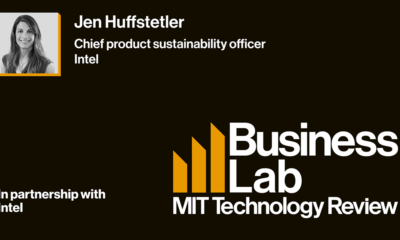Politics
Edge Computing: Igniting the Innovation Revolution Across Industries
Published
2 years agoon
By
Drew Simpson
In the pandemic’s wake, enterprises rapidly relocated their workloads to the cloud to drive continued productivity and ensure business continuity. But is the cloud always the answer? Not always.
Internet of Things (IoT) devices — now 10 billion worldwide — generate tremendous amounts of information in real-time and suffer lackluster performance if they must send the data back and forth to the cloud, resulting in transmission and compute latency, decreased agility, and inflated costs.
This prompted enterprise IT teams to leverage the Edge, a distributed digital architecture that moves computation, storage, and network services near the end-users to boost the quality of app performance.
What constitutes the Edge?
Think of it in two ways. First, there’s the far edge, where enterprise IT teams conduct edge computing on-premise, which can range from brick-and-mortar retail stores to autonomous cars and beyond. These disparate locales all share a common denominator: They’re performing computations at the end-user’s location, where the data is originally collected.
So what’s the real benefit of edge computing? By localizing the data, it doesn’t need to travel, which speeds data up processing, lowers latency, and increases network bandwidth savings. Edge computing is quickly becoming a must-have staple for enterprise IT teams.
In fact, in 2022, more than 40% of companies’ cloud rollouts will integrate edge computing, with the global market forecasted to earn nearly $250 billion in 2024.
What about near-edge and multi-access edge computing?
Alternately, there’s the near edge, which provides multi-access edge computing, a market poised to generate $23 billion by 2028.
MEC enables enterprises to harness real-time cloud services powered off-premises at the service provider’s network edge — occurring at base stations, telco data centers, or points of presence (PoPs). Still residing extremely close to end-users. This results in improved data performance, faster processing speeds, and enhanced storage capabilities.
Far edge and the near edge computing provide the same service
Definitions aside, both the far edge and the near edge provide the same service: Secure, reliable, and performant network connectivity. This can only be achieved through secure access service edge (SASE), which delivers SD-WAN and security-as-a-service to both near and far-edge sites via a global network of PoPs.
Here’s a closer look at how edge computing, SASE, and MEC are transforming end-user data collection, processing, analysis, and storage across industries.
Harnessing the power of edge computing
By 2025, as connectivity requirements scale across industries, 30% of all data will be created and collected in real-time. To enable a real-time response, this data must be processed on premises at the far edge, which positions resources, including storage, computing, and networking, as near as possible to end-users.
This helps customer networks substantially lessen latency, accelerate data processing, and increase bandwidth savings.
Who stands to gain from edge computing?
Everyone — from manufacturing, farming, and healthcare to network optimization, workplace safety, and retail — the possibilities are practically limitless.
In addition to providing solutions for framework issues like bandwidth limitations and network congestion, the implementation of edge computing gives autonomy where reliable connectivity may be hard to come by, plus data sovereignty and security that allow sensitive data to be processed and secured locally via encryption or other methods before it’s sent to the cloud.
Computing for Augmented Reality
Imagine you’re a retail store owner. By offering interactive digital content, you can enhance your customers’ experiences in countless ways. For example, edge computing helps run augmented reality-powered shopping apps like smart mirrors that require real-time human feedback.
And what if you’re riding in an autonomous car? Only through edge computing can your vehicle ingest, process, and analyze data from numerous sources, spanning car sensors to satellite data and much more. This information must be aggregated and processed in real-time, empowering your car’s artificial intelligence to make split-second driving decisions and keeping you safe.
SASE provides cheaper, more flexible solutions to protect data
With the number of monthly active users for mobile augmented reality apps projected to reach 1.9 billion in 2022, combined with the continued popularity of remote work and increasingly complex security threats around the world, enterprises are looking for solutions to securely connect users to business and entertainment resources and applications, no matter what device is being used or where the user is connecting from.
Though effective, SD-WAN is designed to connect branches and specific home workers — inefficient with the growing amount of remote devices and services outside those branches. Enter SASE, which combines the network performance benefits of SD-WAN with a more efficient method of delivering on-demand security services anywhere, similar to other cloud services.
As networks send and access real-time data from various cloud locations, SASE ensures on-demand connectivity and automates the process of protecting both data and end-user devices. By crafting a global network of PoPs that serve as a stepping stone to a variety of cloud services, each PoP can apply the full suite of enterprise security functions, regardless of when or where users, devices, or applications connect.
SASE technology is quickly becoming a core asset for enterprises looking to boost their network security
SASE tech inherently reduces the number of vendors IT teams require, which is cheaper and cuts down on technological complexity. Further, SASE provides better performance for companies that frequently use real-time latency-sensitive collaboration tools thanks to its ability to route through multiple PoPs.
The SASE distributed architecture is optimal for remote work, making it easy for IT to perform security functions for the end user.
As with any new technology, the marketplace is still figuring out what an effective SASE solution looks like. Innovators must continue striving for innovations to provide flexible solutions that don’t compromise scalability for simplicity.
MEC: Revving up data speeds and reducing latency
By 2025, an astounding 175 zettabytes of data will be created annually — with enterprises producing 60% of it. How much data is 175 zettabytes? Better clear your schedule — you’d need 1.8 billion years to download it all.
MEC will help you prepare for this massive shift in big data.
MEC tackles tremendous amounts of information in real-time, performing data analysis, processing, and storage. Instead of running these tasks in distant clouds, they’re performed in base stations, telco data centers, or PoPs at the near edge — via radio access networks — nearby your network, with SD-WAN providing enhanced connectivity and security.
MEC powers ultra-low latency
How does this change the game? MEC powers ultra-low latency, lightning-fast data transmission, and enhanced quality of experience (QoE) for your customers. Additionally, it radically reduces the traffic that’s offloaded to the core network or backend server, freeing these assets up for other business-critical needs.
Like edge computing, MEC supports infinite use cases across industries. For example, manufacturers will use MEC to support agile smart factories. Using MEC, even the tiniest faults or defects can be instantly detected via video and analyzed, empowering engineers to ensure minor issues don’t snowball into major problems.
Law enforcement sees the benefit of MEC too.
Equipped with dash cams in their squad cars and wearing body cameras, British police have struggled to offload all their imagery data to a central place where it can be analyzed and stored. To address this, inside the trunks of their police cruisers, they’ve installed ruggedized UCB-style devices, a video processing unit (VPU), an SD-WAN Edge device, a Wi-Fi card, and dual LTE connections.
So, as officers exited their cruisers, their cameras broadcast over Wi-Fi to a recorder in the trunk of their car. After the VPU processes the data, it’s uploaded over the dual LTE — using SD-WAN technology to improve the quality of connectivity — to a base station at the near edge for video post-processing, analysis, and storage.
Conclusion
To enhance app performance, enterprises around the world are turning to the Edge. At the far edge, data is processed where it’s collected in real-time and extremely close to users, radically reducing latency.
At the near edge, MEC does the heavy lifting, handling volumes of data in real-time and performing data processing and analysis at warp speed, delivering improved end-user QoE. What’s the endgame for IT teams?
By reducing their reliance on the cloud, they can speed data transmission, boost agility, and reduce costs — supporting next-generation innovations that are only limited by imagination.
Featured Image Credit: Photo by Valdemaras D; Pexels; Thank you!
Marilyn Basanta
Sn Director, Product Management, Edge Computing, VMware, Inc.
Marilyn Basanta is the Senior Director of Product Management for VMware’s Edge Compute product line. Formerly a software engineer for IBM, she came to VMware as a solutions architect and built out E2E vertical solutions. She moved into product management and launched VMware TestDrive as part of the End User Computing business unit. Now at VMware for over a decade, she is focused on Edge and is responsible for VMware’s Edge Compute Stack.
You may like
-


The power of green computing
-


China rolls out plan to boost computing power infrastructure
-


Investing in holistic innovation
-


Unlocking the value of supply chain data across industries
-


NFT Revolution: Unveiling the Marketing Agencies Driving Global Adoption of Non-Fungible Tokens
-


This UK startup engineered a clever way to reuse waste heat from cloud computing
Politics
Fintech Kennek raises $12.5M seed round to digitize lending
Published
7 months agoon
10/11/2023By
Drew Simpson
London-based fintech startup Kennek has raised $12.5 million in seed funding to expand its lending operating system.
According to an Oct. 10 tech.eu report, the round was led by HV Capital and included participation from Dutch Founders Fund, AlbionVC, FFVC, Plug & Play Ventures, and Syndicate One. Kennek offers software-as-a-service tools to help non-bank lenders streamline their operations using open banking, open finance, and payments.
The platform aims to automate time-consuming manual tasks and consolidate fragmented data to simplify lending. Xavier De Pauw, founder of Kennek said:
“Until kennek, lenders had to devote countless hours to menial operational tasks and deal with jumbled and hard-coded data – which makes every other part of lending a headache. As former lenders ourselves, we lived and breathed these frustrations, and built kennek to make them a thing of the past.”
The company said the latest funding round was oversubscribed and closed quickly despite the challenging fundraising environment. The new capital will be used to expand Kennek’s engineering team and strengthen its market position in the UK while exploring expansion into other European markets. Barbod Namini, Partner at lead investor HV Capital, commented on the investment:
“Kennek has developed an ambitious and genuinely unique proposition which we think can be the foundation of the entire alternative lending space. […] It is a complicated market and a solution that brings together all information and stakeholders onto a single platform is highly compelling for both lenders & the ecosystem as a whole.”
The fintech lending space has grown rapidly in recent years, but many lenders still rely on legacy systems and manual processes that limit efficiency and scalability. Kennek aims to leverage open banking and data integration to provide lenders with a more streamlined, automated lending experience.
The seed funding will allow the London-based startup to continue developing its platform and expanding its team to meet demand from non-bank lenders looking to digitize operations. Kennek’s focus on the UK and Europe also comes amid rising adoption of open banking and open finance in the regions.
Featured Image Credit: Photo from Kennek.io; Thank you!
Radek Zielinski
Radek Zielinski is an experienced technology and financial journalist with a passion for cybersecurity and futurology.
Politics
Fortune 500’s race for generative AI breakthroughs
Published
7 months agoon
10/11/2023By
Drew Simpson
As excitement around generative AI grows, Fortune 500 companies, including Goldman Sachs, are carefully examining the possible applications of this technology. A recent survey of U.S. executives indicated that 60% believe generative AI will substantially impact their businesses in the long term. However, they anticipate a one to two-year timeframe before implementing their initial solutions. This optimism stems from the potential of generative AI to revolutionize various aspects of businesses, from enhancing customer experiences to optimizing internal processes. In the short term, companies will likely focus on pilot projects and experimentation, gradually integrating generative AI into their operations as they witness its positive influence on efficiency and profitability.
Goldman Sachs’ Cautious Approach to Implementing Generative AI
In a recent interview, Goldman Sachs CIO Marco Argenti revealed that the firm has not yet implemented any generative AI use cases. Instead, the company focuses on experimentation and setting high standards before adopting the technology. Argenti recognized the desire for outcomes in areas like developer and operational efficiency but emphasized ensuring precision before putting experimental AI use cases into production.
According to Argenti, striking the right balance between driving innovation and maintaining accuracy is crucial for successfully integrating generative AI within the firm. Goldman Sachs intends to continue exploring this emerging technology’s potential benefits and applications while diligently assessing risks to ensure it meets the company’s stringent quality standards.
One possible application for Goldman Sachs is in software development, where the company has observed a 20-40% productivity increase during its trials. The goal is for 1,000 developers to utilize generative AI tools by year’s end. However, Argenti emphasized that a well-defined expectation of return on investment is necessary before fully integrating generative AI into production.
To achieve this, the company plans to implement a systematic and strategic approach to adopting generative AI, ensuring that it complements and enhances the skills of its developers. Additionally, Goldman Sachs intends to evaluate the long-term impact of generative AI on their software development processes and the overall quality of the applications being developed.
Goldman Sachs’ approach to AI implementation goes beyond merely executing models. The firm has created a platform encompassing technical, legal, and compliance assessments to filter out improper content and keep track of all interactions. This comprehensive system ensures seamless integration of artificial intelligence in operations while adhering to regulatory standards and maintaining client confidentiality. Moreover, the platform continuously improves and adapts its algorithms, allowing Goldman Sachs to stay at the forefront of technology and offer its clients the most efficient and secure services.
Featured Image Credit: Photo by Google DeepMind; Pexels; Thank you!
Deanna Ritchie
Managing Editor at ReadWrite
Deanna is the Managing Editor at ReadWrite. Previously she worked as the Editor in Chief for Startup Grind and has over 20+ years of experience in content management and content development.
Politics
UK seizes web3 opportunity simplifying crypto regulations
Published
7 months agoon
10/10/2023By
Drew Simpson
As Web3 companies increasingly consider leaving the United States due to regulatory ambiguity, the United Kingdom must simplify its cryptocurrency regulations to attract these businesses. The conservative think tank Policy Exchange recently released a report detailing ten suggestions for improving Web3 regulation in the country. Among the recommendations are reducing liability for token holders in decentralized autonomous organizations (DAOs) and encouraging the Financial Conduct Authority (FCA) to adopt alternative Know Your Customer (KYC) methodologies, such as digital identities and blockchain analytics tools. These suggestions aim to position the UK as a hub for Web3 innovation and attract blockchain-based businesses looking for a more conducive regulatory environment.
Streamlining Cryptocurrency Regulations for Innovation
To make it easier for emerging Web3 companies to navigate existing legal frameworks and contribute to the UK’s digital economy growth, the government must streamline cryptocurrency regulations and adopt forward-looking approaches. By making the regulatory landscape clear and straightforward, the UK can create an environment that fosters innovation, growth, and competitiveness in the global fintech industry.
The Policy Exchange report also recommends not weakening self-hosted wallets or treating proof-of-stake (PoS) services as financial services. This approach aims to protect the fundamental principles of decentralization and user autonomy while strongly emphasizing security and regulatory compliance. By doing so, the UK can nurture an environment that encourages innovation and the continued growth of blockchain technology.
Despite recent strict measures by UK authorities, such as His Majesty’s Treasury and the FCA, toward the digital assets sector, the proposed changes in the Policy Exchange report strive to make the UK a more attractive location for Web3 enterprises. By adopting these suggestions, the UK can demonstrate its commitment to fostering innovation in the rapidly evolving blockchain and cryptocurrency industries while ensuring a robust and transparent regulatory environment.
The ongoing uncertainty surrounding cryptocurrency regulations in various countries has prompted Web3 companies to explore alternative jurisdictions with more precise legal frameworks. As the United States grapples with regulatory ambiguity, the United Kingdom can position itself as a hub for Web3 innovation by simplifying and streamlining its cryptocurrency regulations.
Featured Image Credit: Photo by Jonathan Borba; Pexels; Thank you!
Deanna Ritchie
Managing Editor at ReadWrite
Deanna is the Managing Editor at ReadWrite. Previously she worked as the Editor in Chief for Startup Grind and has over 20+ years of experience in content management and content development.
